It involves cutting a strand of yarn, so may seem scarier than other methods, but it allows an invisible fix, and is easier than dropping the cable back many many rows....
Here we have our miscrossed cable.
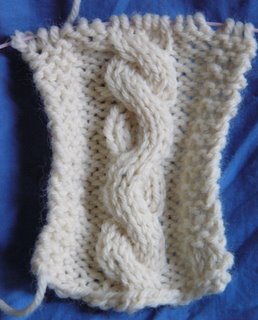
Here is the critical part -- which thread do we cut? If you look at the place where the index finger is really stretching out the yarn, you can see that the thread marked in hot pink is the row before the twist. Those stitches don't want to be there. They want to be in the middle of the cable, where they have happily been for the last few rows. The stitches marked in blue are the row where the twist was made. It's the strand marked in blue that we'll cut.
Choosing the right strand to cut is the only part of this whole scenario for which there is no do-over.
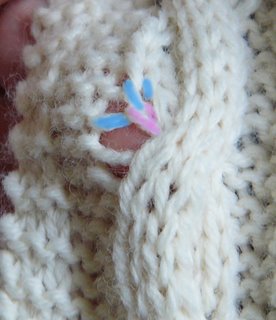
Having identified the right strand, we follow it to the middle of the cable. I checked that I had the right strand about 8 times. Then cut.
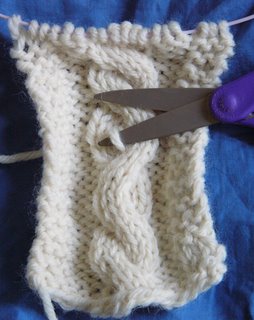
Now the worst is over. Unpick the cable from its middle to each side. I kept the freed stitches on extra needles. Three extras really would have done fine -- only one of the two rows will get twisted, so all six of the stitches in the row above the picked-out row could have started on one needle.

Now's when you put the cross back, with luck, in the right direction this time. Cross one set of three behind the other, and put all six stitches on one needle to hold the crossed stitches in place.

Now kitchener them up.
Weave in your ends, and, hey, presto!, an invisible fix.

Update, 7-4-06
For me, this is a lot less scary than a steek. Steeks scare me, because I know how often I must rip, and once I've cut all those strands.....
The difference, for me, between cutting a steek and this sort of repair, is that the repair involves cutting one (1) strand. Those two cut ends require one join each -- two (2) joins, total. Each cut end is joined to an end of the short piece I added when kitchenering. My continuous strand is maintained. So if I need to rip, I can. I could even eliminate the bit of yarn used for kitchenering and join the two cut ends of my original strand, if I did end up having to rip.
One more thought -- joins are easy to hide in a cabled fabric.........
Update, 7-5-06
I assumed the joins, rather than describing them. I'll rectify that now.....
What I do, generally, when I join two strands, is work both of them at the same time for two or three stitches, and come back after a few rows and weave in the ends. When I join two balls of yarn in the same project, that's what I usually do.
In this case, what I did was unpick just to the edge of the cable, but I began the kitchenering a couple of stitches further into the knitting. I worked duplicate stitch (in the same row as the cut strand) for a couple of stitches, then kitchenered the ends of the cable, then worked another couple of stitches of duplicate stitch at the other edge of the cable.
With a really slippery yarn, I bet it would be a good idea to have a knot. I've never used a really slippery yarn.... The test yarn was partly wool, and I guarantee you that those joined ends aren't going anywhere. Wool is a nice friendly fiber and wants to help you. It won't sneakily unravel itself, out of sheer meanness.
I urge you to knit a tiny swatch, and cut one thread in the middle. Then pull, pull, pull, viciously, in every direction, and see what happens. It's not anything like nylon stockings, which *zip* a terrible run while you watch in dismay. You may find that one stitch unravels, or two, and maybe one or two will run a few stitches in either direction, but you will need to work to make them do so. With wool in your yarn, I promise you it will be an annoyance rather than a disaster to mend. Not that you want to mend the swatch, though it would be excellent practice for mending a sweater, but *if* you wanted to mend it, it would be easy.
As Elizabeth Zimmermann said, I am the boss of my knitting. I recommend her book Knitting without Tears -- if you don't have it, check it out of the library and see, and I bet you'll want to add it to your library. EZ does an excellent job of making the mechanics of knitting clear and understandable.







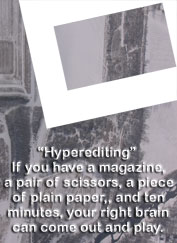
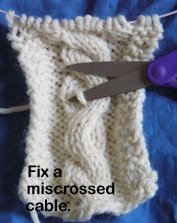








21 comments:
I would drop the cable back, too, if it were a smallish number of rows, but if it were way back.....
This is what I had in mind, too! Nice walkthrough.
Thanks for your comment re: the cormo! I, too, like to see the lanolin billowing out. It's hard to keep from over-agitating just to see more escaping...
Wow - that's... really scary. The fix looks perfect afterward though - maybe I'd brave it if I'd messed up a cable reeeeally far back. :)
Brilliant, and really, really scary. I react to this as I do to steeks: you want me to cut my precious knitting???
I'm gonna remember this, though. Someday I will need it.
Steeks scare me, too, because I know how often I must rip, and once you've cut all those strands.....
The difference, for me, between cutting a steek and this sort of repair, is that the worst thing that can happen with the repair is that you have a couple of extra joins in your yarn (and on a cabled fabric, those are pretty easy to hide....).
If you should have to rip, you could, and you could easily re-knit, because your continuous strand is still there (just with a couple of extra joins, one of which you could eliminate, if you had to rip....).
Wow. That's impressive. Thank you for sharing!
Sorry, I'm still kinda a beginner, and I don't understand why something, somewhere, wouldn't unravel because you cut a stitch. Wasn't that stitch attached to something else, and wouldn't it unravel behind the cable? Pardon my ignorance. The kitchener-ing doesn't resolve the cut, only the crossed cable, right?
This is kind of like diffusing a bomb, isn't it?
Nah, more like rearranging books on your shelf that aren't in the right order. :-)
No looming catastrophe (well, ok, depending on your yarn -- if you are knitting with nylon cord, it will be worse than if you are knitting with wool).
As my boss might suggest, try a science experiment.
Try knitting a tiny swatch, and cut one strand in the middle. See what happens (or doesn't!). Pull on it, hard, from every direction. See what happens, or doesn't....
Of course it makes a difference what your yarn is made of. If your yarn is wool (a friendly and helpful fiber), I promise you no disaster will befall..... :-)
THIS IS EXACTLY WHAT I NEED TODAY!!!!! Thank you so, so much!
Okay, as Sally said, it's like diffusing a bomb. Only here's the thing. I was actually on the bomb squad and I can say with authority that diffusing a bomb is easier. Granted, the consequences of an error are a bit worse, but I couldn't live with a miscrossed cable any more than I could live with a live bomb in the kitchen.
Unlike the bomb (which hasn't yet gone off), the miscrossed cable has already happened. :-) Cutting the one thread to fix the backwards cross can't cause a disaster, whereas cutting the wrong wire might, when defusing a bomb, right?
I want to say I with I knew about this, before I undid 29 cm of 12 ply aran to fix my mistake.
I have linked this post to my blog, for anyone who is in the same boat I was. I do hope you don't mind.
You saved me! What fantastically clear images and instructions for a mediocre knitter to follow. Thank you.
Cheryl, thank you for writing. How nice to hear such kind words.
Glad to have been of help. :-)
Thanks for this! I just stumbled upon it when looking for (you guessed it) ideas on how to fix a miscrossed cable. Great idea, worked perfectly! Just have to smooth out the tension on my kitchener, and I'm back in business! Thank you. -Carolyn
Carolyn, thank you for writing! I'm glad it was useful!
Cutting one strand of wool -- really not that scary. :-)
A pretty easy fix, all around. :-)
I have tried this method with various yarns and all I end up with is a big hole. I don't know where to kitchner. Could you post this technique on You Tube? I think it would be helpful to many knitters like me that need a visual approach. Thank you.
I can imagine that video might be helpful, Gina. Maybe one day I can do that.
Ok ... now I've come up to the solution for me to never, ever cut my yarn like that! Whew!
My solution:
Never ever make that mistake. Easy.
Lol, Anon. :-)
I urge you to play with this idea on a swatch. Forget the cable -- just knit a small swatch, cut a thread in the middle, and see what happens.
If you are using wool yarn, nothing will happen as a result of the cut. The yarn will be cut, but no other stitches will be impacted.
If you pull on the swatch, hard, in every direction, you will only get minor movement (NOTHING like what happens with nylon stockings when you are wearing them -- nylons are very slippery "yarn," under tension around your leg).
Wool wants to stick to wool, and won't go anywhere without ... persuasion.
I urge you to try it, because seeing for yourself what really happens (or doesn't) helps give you power over your knitting. Testing on a piece you don't care about can give confidence for dealing with unwanted situations in the future.
Knowledge (especially knowledge gained through your own hands-on experimentation) really is power.
:-)
Post a Comment